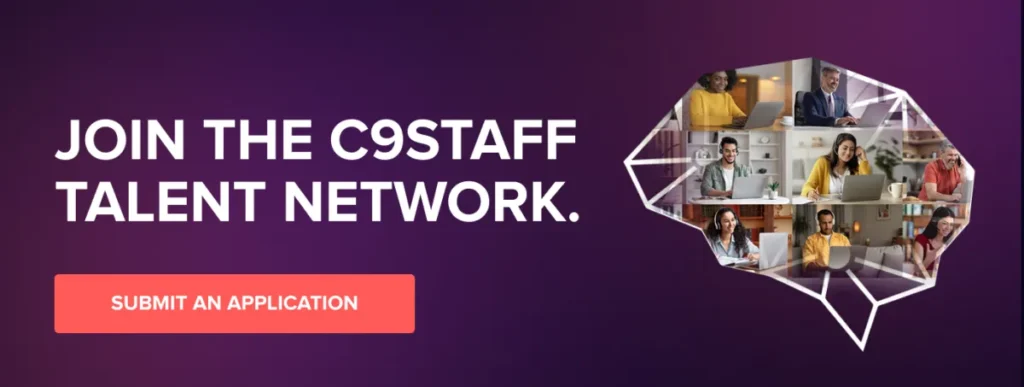Introduction

The role of a Training and Development Specialist has never been more crucial in modern organizations. As workforce dynamics evolve and technological advancements accelerate, the demand for continuous learning within companies intensifies. These specialists are at the forefront, enhancing employee skills, boosting morale, and ensuring compliance with evolving industry standards. Their work is vital in equipping staff with the necessary tools and knowledge to thrive in a rapidly changing environment, thereby directly contributing to organizational success.
If your goal is to secure the best job description template available—one that serves as an exemplary foundation for drafting your own hiring specifications—look no further. By following the link below, you can download our complimentary Training and Development Specialist Job Description. This document embodies the fundamental principles and top practices of C9Staff’s esteemed hiring methodology, ensuring you start with a template that is both comprehensive and strategically tailored to attract top-tier talent.
Training and Development Specialist Job Description Template

This article is tailored for two key audiences: employers who are on the lookout to hire and job seekers eager to fill this pivotal role. For employers, we will delve into crafting detailed and effective job descriptions that not only attract the right candidates but also stand out in the competitive market. We’ll explore benchmarking strategies to ensure that your offerings are competitive and appealing. For job seekers, this guide will clarify the essential qualifications and skills required to excel as a Training and Development Specialist and how best to highlight these in your applications.
As we progress, we will thoroughly examine the responsibilities, required skills, and the emerging trends that are shaping this role. This guide aims to be your definitive resource for mastering the art of developing or responding to a Training and Development Specialist job description. Whether you’re looking to hire or hoping to be hired, this article will equip you with the knowledge and tools to navigate the complexities of the job market successfully, ensuring you are well-prepared to either draft or respond to a job description that captures attention and meets contemporary professional standards.
Empowering Success: Mastering Employee Training & Development
Understanding the Role of a Training and Development Specialist

The role of a Training and Development Specialist is central within any organization’s human resource’s structure. These specialists are instrumental in identifying training needs, designing tailored training programs, and implementing these strategies to elevate employee skills throughout the company. Their work is pivotal in aligning employee capabilities with the strategic goals of the organization, thereby enhancing overall operational efficiency.
Training and Development Specialists directly influence employee performance, satisfaction, and company-wide growth. By crafting effective training programs, they not only enhance individual employee skills but also contribute significantly to creating a motivated and competent workforce. Their efforts in fostering a culture of continuous improvement and learning are crucial in supporting both personal career development and organizational objectives.
For employers, the integration of a dedicated Training and Development Specialist into your HR team can translate into substantial returns on investment through increased productivity and better employee retention. For job seekers, pursuing a career as a Training and Development Specialist offers a dynamic and impactful path, where you play a key role not only in education but in strategically developing the workforce.
As we proceed, the forthcoming sections will delve into the specific responsibilities, required skills, and the latest trends that shape this role. This introduction sets the foundation for a deeper exploration, equipping you with a thorough understanding of the pivotal impact and strategic importance of the Training and Development Specialist within an organization. Whether you are an employer looking to enhance your team’s capabilities or a job seeker aiming to enter this field, the insights provided will prepare you for a comprehensive engagement with this essential position.
Core Responsibilities and Job Duties

The role of a Training and Development Specialist is pivotal in any organization, tasked with the essential responsibilities that foster a skilled, motivated, and agile workforce. Here, we detail these key responsibilities and their strategic significance.
Typical Job Responsibilities
Conducting Needs Assessments: Specialists start by identifying the skills, knowledge, and capabilities that employees need to succeed in their roles. This involves analyzing job duties, speaking with supervisors, and using performance metrics to pinpoint areas of improvement.
Designing Training Programs: With a clear understanding of needs, they design tailored training programs. This involves selecting appropriate training methods (e.g., workshops, e-learning courses) and materials that resonate with diverse learning styles and organizational goals.
Implementing Training Programs: The execution of these programs requires meticulous organization and management skills, ensuring that training is delivered effectively, within budget, and on schedule.
Evaluating Program Effectiveness: Post-training, they assess its impact. This includes gathering feedback, examining changes in performance metrics, and determining ROI of training initiatives to continuously refine and improve training strategies.
Alignment with Broader Business Goals The responsibilities of a Training and Development Specialist align closely with broader business goals and organizational strategies:
Upskilling Employees: Training programs are not just about skill enhancement; they’re about preparing the workforce for future challenges, fostering innovation, and driving the company’s competitive edge in the market.
Enhancing Job Satisfaction: Effective training increases job satisfaction and employee engagement by showing investment in employees’ professional growth, leading to lower turnover rates.
Driving Organizational Success: By aligning employee growth with strategic objectives, training and development efforts contribute directly to achieving business outcomes, such as increased productivity and efficiency.
Dual Context Importance
For Employers: Understanding and defining these responsibilities in job descriptions is crucial. It ensures you attract candidates who are capable of shaping effective training programs that align with strategic objectives.
For Job Seekers: Mastery of these responsibilities can set you apart as a candidate, demonstrating your ability to contribute significantly to organizational development and success.
Required Skills and Qualifications

The role of a Training and Development Specialist is critical in shaping the workforce of any modern organization, requiring a specific set of technical and soft skills that are essential for success. Firstly, technical skills such as instructional design and proficiency with e-learning platforms are indispensable. These skills enable specialists to create effective, scalable training programs that meet diverse learning needs and stay abreast of educational technology trends, ensuring that training is both current and accessible.
Transitioning to soft skills, effective communication stands out as paramount. It allows specialists to clearly articulate training programs and engage with diverse audiences, ensuring that the content is understood and applied correctly. Leadership is equally crucial, driving training initiatives and fostering an organizational culture that values continuous learning and improvement. Additionally, adaptability and problem-solving skills are essential as they equip specialists to navigate the ever-changing challenges of organizational development.
The educational background of a Training and Development Specialist also plays a significant role in their effectiveness and career progression. Degrees in education, human resources, or organizational development provide a solid foundation for understanding the theoretical aspects of training and people management. Moreover, professional certifications like the Certified Professional in Learning and Performance (CPLP) or Certified Training and Development Manager enhance a specialist’s credentials, demonstrating their commitment and expertise to prospective employers.
For employers, it is crucial to clearly list these skills and qualifications in job descriptions to attract candidates who are not only qualified but also capable of significantly contributing to organizational goals. For job seekers, showcasing these skills and qualifications in applications can distinguish them from other candidates, highlighting their readiness and suitability for the role.
Crafting the Perfect Job Description

Crafting the perfect job description for a Training and Development Specialist is crucial not only for attracting the right candidates but also for communicating your organization’s culture and expectations effectively. A well-written job description serves as a strategic tool, defining the role’s significance within the company and outlining the impact the position has on organizational success.
Step-by-Step Guide to Writing a Compelling Job Description:
Title and Role Overview: Begin with a precise, engaging title that accurately reflects the scope of the role. Follow this with a succinct overview that highlights the role’s critical importance to the organization’s objectives and its influence on company culture and employee growth.
Detailed Responsibilities: Clearly list the essential responsibilities of the Training and Development Specialist. Each responsibility should be described in a way that shows its connection to the broader business goals and learning strategies of the organization. For instance, detailing how the specialist will conduct needs assessments, develop tailored training programs, and measure the effectiveness of these initiatives in terms of employee performance and satisfaction.
Required Skills and Qualifications: Specify the technical skills needed, such as expertise in instructional design and familiarity with e-learning platforms. Also, outline the soft skills required, like exceptional communication abilities and leadership qualities, and explain how these contribute to successful training outcomes. Mention the educational background and professional certifications that enhance a candidate’s suitability for the role, supporting these requirements with how they enable the specialist to meet the job’s demands.
Incorporating SEO-Friendly Keywords: Discuss the importance of using specific keywords and phrases that improve the job description’s visibility on job boards and search engines. Provide tips on how to identify and integrate these keywords naturally into the job description, enhancing the chances of attracting well-qualified candidates.
Legal and Compliance Considerations: Emphasize the necessity of adhering to legal standards and avoiding discriminatory language. Highlight the importance of inclusive language that promotes diversity. Outline any specific legal or industry regulations that must be considered when drafting the job description to ensure compliance and avoid legal pitfalls.
If your goal is to secure the best job description template available—one that serves as an exemplary foundation for drafting your own hiring specifications—look no further. By following the link below, you can download our complimentary Training and Development Specialist Job Description. This document embodies the fundamental principles and top practices of C9Staff’s esteemed hiring methodology, ensuring you start with a template that is both comprehensive and strategically tailored to attract top-tier talent.
Training and Development Specialist Job Description Template

Benchmarking and Competitive Analysis

Understanding how to benchmark a job description against market standards is crucial for employers seeking to remain competitive and attract top talent. A comprehensive, competitive job description not only meets compliance standards but also positions an organization as a desirable place to work, directly influencing its ability to attract skilled professionals.
Step-by-Step Guide to Benchmarking a Job Description:
Identify Key Competitors: Begin by identifying direct competitors and other organizations that hire for similar roles within your industry. Understanding who you are competing against for talent is crucial for setting the right benchmarks.
Use Industry Surveys: Engage with industry surveys and detailed reports that shed light on standard job descriptions, salary ranges, and benefits for comparable positions. This information will serve as a foundational benchmark to compare your job descriptions against what is currently offered in the market.
Utilize Salary Comparison Tools: Tools like Glassdoor, Payscale, and LinkedIn Salary Insights can provide valuable insights into the current salary expectations and benefits offered for similar roles. These tools help ensure that your compensation packages are competitive and aligned with current market trends.
The Importance of Competitive Salaries and Growth Opportunities:
Offering competitive salaries and clear paths for career advancement are not merely additional benefits but essential strategies for attracting and retaining the best candidates. Competitive compensation packages are directly linked to lower turnover rates, higher employee satisfaction, and overall organizational success. These factors make your organization stand out as an employer of choice.
Effective Use of Industry Surveys and Salary Comparison Tools:
Analyzing Data: Analyze the data collected from industry surveys and salary tools to understand where your job offerings stand in relation to the market. This analysis will help you identify areas where adjustments may be needed, whether it’s enhancing the salary package, benefits, or other job perks.
Continuous Monitoring: Regularly review and update your compensation strategies to keep pace with evolving market trends and changes. This continuous monitoring ensures that your organization remains competitive and can adapt to shifts in what candidates expect from potential employers.
Insights for Job Seekers

In today’s competitive job market, especially for positions such as Training and Development Specialists, standing out with a tailored resume and personalized cover letter is more crucial than ever. This strategic approach not only highlights your attention to detail but also showcases your genuine interest in the role, making a strong first impression on potential employers.
Tailoring Resumes and Cover Letters:
Highlight Relevant Experience: Start by carefully reading the job description provided by the employer. Identify key responsibilities and qualifications, and then highlight your experiences that directly align with these requirements. This method ensures that your resume speaks directly to the needs of the organization, making it clear why you are the ideal candidate for the job.
Use Keywords: Incorporate industry-specific keywords and phrases found in the job description into your resume. These keywords help your application get noticed not only by hiring managers but also by Applicant Tracking Systems (ATS), which many organizations use to filter applications. The right keywords can be the difference between your resume being seen or overlooked.
Customize the Cover Letter: Personalize your cover letter for each application. Show that you understand the company’s goals and how your background makes you not just a suitable candidate, but the perfect fit. This personalized approach demonstrates your dedication and interest in the role, distinguishing your application from others.
Preparing for Interviews:
Research the Company: Before the interview, spend time researching the company’s culture, recent achievements, and goals. Understand the department you aim to join, and frame your responses and questions to align with the company’s strategic direction. This preparation shows your commitment and genuine interest in becoming part of their team.
Practice Common Interview Questions: Prepare for typical interview questions that are relevant to Training and Development roles. For example, be ready to discuss specific past experiences with designing and implementing training programs, including what challenges you faced and how you overcame them. This preparation helps you articulate your experiences more effectively.
Discuss Skills and Experiences Effectively: In the interview, focus on discussing the impact and results of your previous work, rather than just listing duties. Explain how your efforts improved training outcomes, enhanced employee engagement, or contributed to the organization’s goals. This approach demonstrates your ability to translate skills into tangible results.
Addressing the Reader Directly:
Whether you are new to the field or a seasoned professional seeking advancement, it’s important to showcase your unique attributes. New entrants should emphasize adaptability, a quick learning curve, and enthusiasm for the field. More experienced professionals should highlight a proven track record of impactful training programs and strategic insights into organizational development.
If you’re ready to supercharge your career and land your dream job, C9Staff is here to help. Click the link below to submit your resume to our talent acquisition department. If your qualifications align with our client requirements, we will be in touch to discuss potential opportunities that match your profile. Don’t miss the chance to make your career aspirations a reality—submit your resume today!

Future Trends in Training and Development
The rapid evolution in technology and cultural norms is profoundly reshaping the field of training and development, emphasizing the importance of staying abreast of emerging trends. These trends, such as digital transformation, artificial intelligence (AI) in training, and a heightened focus on diversity and inclusion, are not just altering the tools and methods used in training—they are transforming how training aligns with strategic business outcomes, making adaptability and forward-thinking crucial for success.
Digital Transformation: As digital technology advances, so does the scope for robust and scalable training solutions that cater to individual learning needs. E-learning platforms are increasingly employing adaptive learning technologies, allowing for personalized educational experiences that enhance learner engagement and retention.
AI in Training: AI’s role in training extends beyond just personalized learning; it is revolutionizing administrative aspects of training operations. AI technologies are being used to automate tasks like data analysis and the generation of tailored learning experiences, providing real-time feedback to learners and trainers alike. This not only improves the efficiency of training programs but also their effectiveness, ensuring that training goals are met more swiftly and successfully.
Diversity and Inclusion Training: In today’s global business environment, diversity and inclusion have become more than just HR buzzwords—they are integral to an organization’s fabric. Training programs are increasingly including diversity and inclusion components to cultivate a workplace culture that respects and leverages diverse perspectives, thereby enhancing team innovation and overall company performance.
For employers and HR professionals, integrating these advanced technologies and methodologies into training programs is crucial for staying competitive. It not only enhances the appeal and effectiveness of these programs but also positions the organization as a forward-thinking employer.
For job seekers and training professionals, staying current with these trends is equally important. Continuous learning and obtaining certifications in new technologies and methodologies can significantly enhance your marketability and equip you to contribute effectively to future-oriented organizations.
If you are looking to source, recruit, hire, train, manage, and deploy the ideal candidate for a Training and Development Specialist within your organization, C9Staff invites you to explore our comprehensive services. Click the link below to schedule a free exploratory call with one of our dedicated account managers today. During this call, we will carefully listen to your needs and provide endorsements for potential candidates at no cost, helping you evaluate the best talent available at competitive prices.

Conclusion

As you conclude your reading, take a moment to reflect on the journey through the intricate landscape of the Training and Development Specialist role. Your understanding now spans from the fundamental definitions to the strategic crafting of job descriptions and the vibrant future trends shaping this vital position.
Throughout this article, we’ve navigated through the crucial aspects of what makes a Training and Development Specialist not just a job title, but a cornerstone of organizational success. From defining the role’s pivotal place within HR structures to outlining the responsibilities and skills needed, we’ve covered ground that is essential for both employers and job seekers.
The strategic crafting of job descriptions, as we discussed, is not merely about listing requirements and responsibilities; it’s about creating a beacon that attracts the right talent—talent that is aligned with the company’s vision and growth. These job descriptions are pivotal tools for employers, serving as the first touchpoint to engage potential top-tier candidates who can drive forward company objectives.
For candidates, the journey does not end with fitting into a role. It is about continuously evolving and adapting. The field of training and development is ever-changing, influenced by technological advancements, shifting market needs, and new educational insights. Embracing a path of continuous learning and development is crucial. It ensures that you remain competitive and relevant, helping you to not only meet the demands of current roles but also to prepare for future challenges.
In closing, whether you are drafting a job description or tailoring your resume, remember the importance of precision and adaptation. I urge all employers and job seekers to embrace the guidelines provided for crafting superior job descriptions and pursuing continuous professional development. Let these practices be your guide to enhancing organizational success and personal career growth. Commit to excellence, remain curious, and be proactive in your professional journey.




